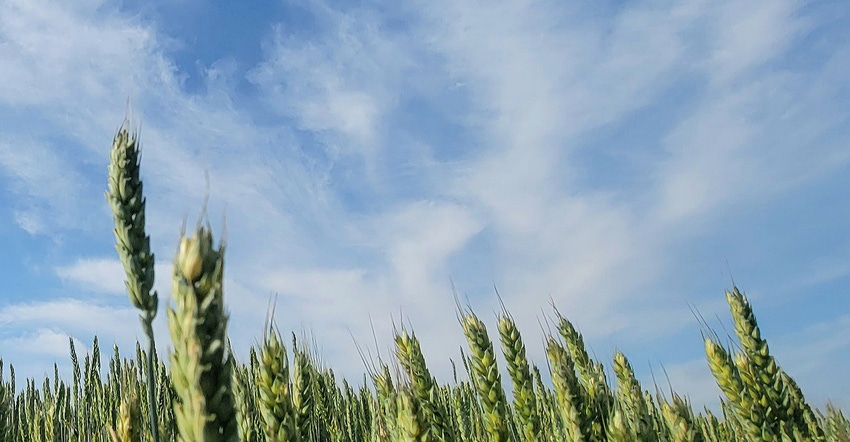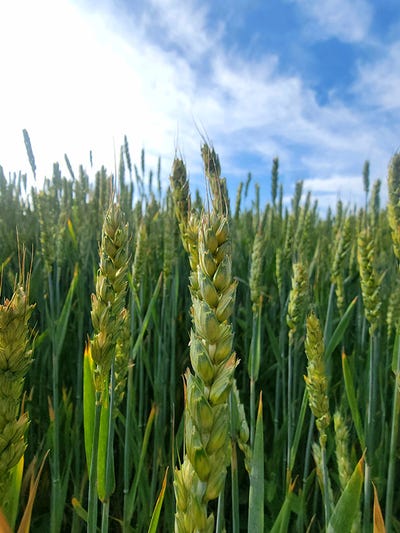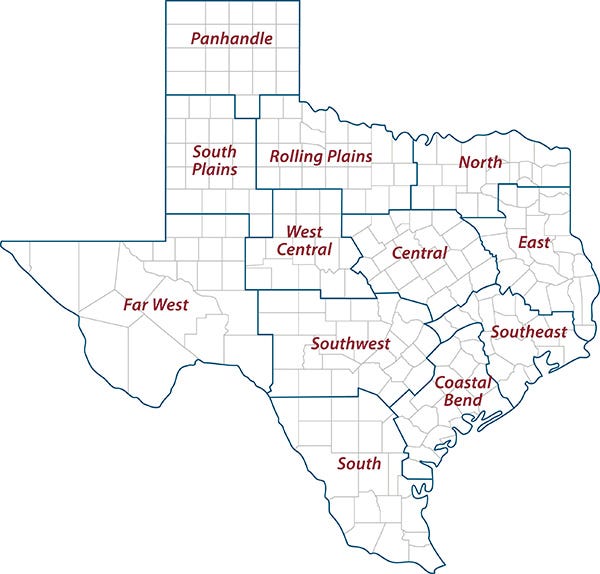
High fertilizer prices and dry weather have many Texas wheat farmers facing critical decisions regarding the viability and profitability of their crop, according to a Texas A&M AgriLife Extension Service expert.
Calvin Trostle, AgriLife Extension agronomist, Lubbock, said wheat producers around the state, especially those in areas experiencing drought, need to consider ways to minimize inputs and maximize crop output potential.
Trostle said wheat producers in the Texas High Plains are dealing with extreme to severe drought and face a decision on whether dryland fields are worth saving. Many later-planted fields across the region have not emerged, and dryland field trial wheat plots Trostle planted Nov. 5 have only produced about a 2% stand so far.
 Mother Nature will weigh heavily on many dryland producers’ decision to apply nitrogen fertilizer and how to time it. Producers with irrigation will have options, says Calvin Trostle, AgriLife Extension agronomist, Lubbock. (Photo by Shelley E. Huguley)
Mother Nature will weigh heavily on many dryland producers’ decision to apply nitrogen fertilizer and how to time it. Producers with irrigation will have options, says Calvin Trostle, AgriLife Extension agronomist, Lubbock. (Photo by Shelley E. Huguley)
Earlier-planted fields around the region have fared better and are at least established, he said, but still need rainfall badly.
“Producers are talking about input prices, especially fertilizer, and the potential for their wheat,” he said. “Wheat may look like it’s not worth saving, but we’ve been surprised in the past. Wheat is tough and can take off, but it will need moisture at some point.”
High fertilizer prices cause concern
Trostle said weather patterns will make the decision for most producers, but there are ways to potentially capitalize on past fertilizer applications and optimize future top dressings. Reducing input could be the difference between production budgets ending in the black or the red.
Recent Texas nitrogen fertilizers with no phosphorous or potassium like 32-0-0 urea ammonium nitrate and 46-0-0 urea were $645-$695 per ton and $910-$950 per ton, respectively. Trostle said these prices equated to a $1 to $1.09 per unit price for actual nitrogen, and before now he had never seen above the low-70 cent range.
Trostle said some price forecasts project fertilizer and grain prices may pull back somewhat. But the timing of any dip in fertilizer prices may not be in time for wheat producers in the southern half of Texas to benefit, and future dips in wheat prices would add another element of concern.
Wheat fields in South and Central Texas typically receive top-dress nitrogen applications in February compared to March in the High Plains.
See, WHEAT SCOOPS: What’s out there to change wheat prices?
“We may see the unit prices go down, but the question will be the crop’s condition and moisture prospects,” he said. “Producers will also have to consider wheat price projections and the yield potential at harvest.”
Optimize fertilizer applications with timing
Trostle said producers with irrigation will have options regarding timing their nitrogen application because they can water it in. But Mother Nature will weigh heavily on many dryland producers’ decision to apply nitrogen fertilizer and how to time it.
“Timing the application with a weather system that is likely to deliver rain or melting snow to incorporate the nitrogen into the soil is critical to minimize losses,” he said. “But it’s also important to make sure there is nitrogen in the soil a week before wheat begins to joint and plants shift their energy from vegetative growth toward reproductive growth.”
Available nitrogen is critical at this stage, Trostle said, because it influences yield outcomes. The period, which lasts around seven days, will determine spikelet numbers on the wheat head and how many seeds per spikelet. These are strong components of yield potential.
Trostle said 24 spikelets per head is good, but that a lack of nitrogen can limit yield potential. Inadequate nitrogen coupled with poor moisture can have a significant impact on grain yields.
Because timing fertilizer applications with moisture is important before joint stage, Trostle said dryland producers should consider applications ahead of any significant forecast for potential moisture. Sticking to a schedule and growth stage could decrease the application’s value to the crop if drier than normal weather conditions hold after a topdressing of nitrogen is applied.
“Putting nitrogen out won’t help until rain or irrigation, so they have to ask themselves, ‘Have I ever gone six weeks without rain in February or early March?’” he said. “If you’re next opportunity might be six weeks out and you miss the opportunity to get fertilizer nitrogen into the root zone, then you’ve missed the opportunity to positively impact yields.”
Beyond post-application rainfall, temperatures are also an important factor in reducing gaseous loss of surface-applied ammonium-based fertilizers, Trostle said. Applications lose less nitrogen in cooler temperatures – below 60 degrees – compared to warmer temperatures.
Optimize fertilization with deeper, more detailed soil analysis
Deeper assessments of nitrate availability for crops could yield savings for producers while fertilizer prices remain high, Trostle said.
AgriLife Extension’s typical recommendation includes sampling to a depth of 6 inches at minimum, but Trostle recommends a companion analysis for soil nitrates as much as 24 inches deep.
Trostle said studies have revealed as much as 50-60 pounds of nitrate-nitrogen per acre at those depths, which established wheat stands can access. This residual nitrogen could reduce the amount of fertilizer needed further along in wheat’s long growing season.
“In-season soil sampling is not something we typically talk about, but the wheat season is long, and a companion analysis that looks at subsoil nitrogen could reduce the nitrogen that is really needed for surface application,” he said. “Some farmers find a lot more nitrate residuals than they expected, and that represents savings.”
AgriLife Extension district reporters compiled the following summaries:

CENTRAL
Dry conditions continued but rainfall was in the forecast. Isolated small wildfires occurred. Burning bans were in effect. Fields were prepped for corn planting. Heavy frost occurred over the past two weeks, which resulted in Bermuda grass pastures finally going dormant. The heavy frosts damaged winter oat fields that were at or approaching elongation stage. Oat tops were browning with no available soil moisture to recover. Grazing quality and quantity was impacted and will be slower to recover. Winter wheat also showed frost damage on the upper leaves but much less than winter oat fields. Growers were waiting for cold conditions to promote successful preemergence herbicide applications to pastures with sandburs and other spring-germinating broadleaf weeds. Seeds for certain cotton varieties were booked, and growers were looking for decent alternatives and herbicides because availability may be an issue. Fertilizer prices were up 200% from last year, and crop prices had not improved, which may impact corn acres and/or yields. Stock tanks were showing major level drops throughout the fall and winter. Supplemental feeding was necessary for all livestock.
ROLLING PLAINS
Conditions were very dry and windy, causing fire concerns. Pasture and rangeland conditions were mostly very poor. The lack of moisture and emergence made it difficult to tell what wheat fields were planted. Emerged wheat was grazed by stockers, and producers were relying on hay supplies that were tightening. Stock tanks were drying up and cattle were getting stuck in the mud attempting to access water.
COASTAL BEND
Conditions were mostly dry. Producers worked fields to control weeds, and some were fertilizing. Preparations were being made to planters and equipment. Corn planting should begin in the next three weeks. Freezing temperatures in the northern portion of the reporting area caused a decline in pastures and forage. Rangeland and pasture conditions were fair in most areas. There was some standing forage, but little of nutritional value. Hay inventories were plentiful. Livestock producers were feeding hay, protein and energy. Livestock markets were still selling moderate numbers of cattle with steady to higher prices. Livestock were in good condition.
EAST
Conditions have become extremely dry in parts of the district. Beyond a few arctic cold fronts, the weather was relatively mild so far this winter. Cold temperatures hit winter pastures hard as well. Some winter wheat looked decent, but the lack of moisture was delaying recovery from freezing temperatures. Livestock were in good condition. Ponds were becoming a major concern, and animals were getting stuck in deep mud trying to access water.
SOUTH PLAINS
Conditions were very dry with above-average temperatures. All crops were harvested.
PANHANDLE
Dry, cold conditions persisted. Moisture was extremely limited. Drought conditions were affecting winter wheat and native pastures. If significant rains do not arrive by April, only irrigated corn acres will be available for planting. Some very light snow occurred midweek to halt farming activities, but it made no difference in the extremely dry soil moisture conditions. Some producers were irrigating wheat on warmer days. Some pre-plant tillage was occurring for summer crops. Cattle on rangelands were receiving supplemental feed.
NORTH
Soil moisture was very short to short and continued to decline across the district. Temperatures were cold and windy. Cold, dry conditions were damaging to the winter wheat and pastures. Livestock were in good condition. Ponds were becoming a major concern due to water level declines. Some animals got stuck while wading out in deep mud to access water.
FAR WEST
Conditions were very dry, and temperatures were warm for this time of year. Daytime temperatures varied from the mid-40s to the mid-60s with overnight highs between the upper 30s and 16 degrees one night. Light snow flurries were reported, but nothing stuck, and no recordable precipitation occurred. Cotton ginning continued and will most likely go on for another month. Yields and grades were excellent this season. Wheat conditions worsened. About 5% of planted fields emerged, and dryland fields that emerged were dead. Irrigated wheat on drip systems had not emerged between the tapes. Growers who dug ditches to install new drip irrigation said there was no moisture up to 6 feet in ground depth. Rangeland and pastures were very hard and dry. Cattle were receiving supplemental feed, and more producers were thinning herds due to lack of forages and high feed costs. Pecan farmers continued harvesting pecans.
WEST CENTRAL
Conditions were extremely dry. Severe drought conditions continued, and wildfires were a concern. A few small fires were reported, but minimal damages were reported. A cold front moved through midweek and brought colder temperatures. Winter wheat was in very poor shape. Small grains were dying due to lack of soil moisture.
SOUTHEAST
Heavy rains arrived with a cold front. Pastures and fields were too wet for fieldwork with more rain in the forecast. Most areas reported short to adequate soil moisture. Pasture and rangeland conditions were fair to good. Cold temperatures burned cool season pastures several weeks ago and were slowing recovery. Another killing freeze was in the forecast.
SOUTHWEST
Cold fronts produced trace amounts of precipitation across the district. Pasture and rangeland conditions continued to decline with the lack of moisture. Wheat and oat crops were in fair to good condition. Preparation for spring corn and sorghum planting was underway. Livestock were in fair condition. Producers continued supplemental feeding of both livestock and wildlife.
SOUTH
The northern, western and eastern parts of the district continued to experience dry weather and very short soil moisture levels. Southern areas reported wet conditions and adequate soil moisture. Farmers were idle and waiting for rainfall to be forecast so they could apply preplant fertilizers and chemicals. The lack of rain was impacting oat field production. Winter Garden crops like cabbage and spinach were doing well, and fields were being prepared for spring planting. Growers in Hidalgo County were expected to begin planting corn and sorghum following recent rainfall. Citrus and sugarcane were harvested. Temperatures swung from warm to cold with daytime highs ranging from the high 60s to the low 40s. Rangelands were dormant due to lack of moisture but looked good in areas with moisture. A freeze around three weeks ago knocked back green grasses in some areas, and while some were recovering, dry conditions were slowing the process. Ranchers were feeding cattle and other livestock and providing protein for wildlife. Cattle were beginning to browse pear cactus, and cattle body conditions were declining in some areas. Ranchers reported hay supplies were plentiful. Coastal Bermuda grass round bales were selling for $50-$65. Stock tanks were low and declining. Cattle sales were consistent with 400–500-pound steers selling for $1.47-$1.75 per pound. Heifers in the same weight class were selling for $1.30-$1.52 per pound.
Source: is AgriLife TODAY, which is solely responsible for the information provided and is wholly owned by the source. Informa Business Media and all its subsidiaries are not responsible for any of the content contained in this information asset.
About the Author(s)
You May Also Like




